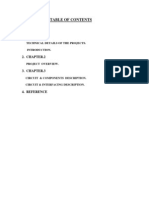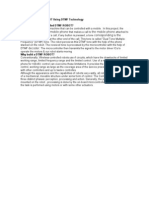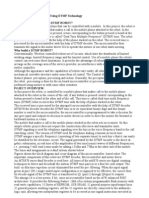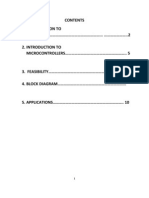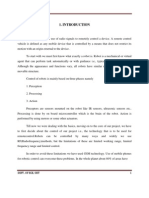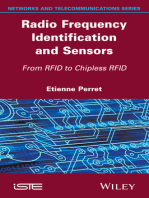DTMF Based Controlled Robot Vehicle: February 2015
Uploaded by
tahaDTMF Based Controlled Robot Vehicle: February 2015
Uploaded by
tahaSee discussions, stats, and author profiles for this publication at: https://www.researchgate.
net/publication/273074456
DTMF Based Controlled Robot Vehicle
Article · February 2015
CITATION READS
1 18,370
1 author:
Raj Hakani
Nirma University
12 PUBLICATIONS 5 CITATIONS
SEE PROFILE
Some of the authors of this publication are also working on these related projects:
GTU ROBOCON View project
GTU ROBOCON View project
All content following this page was uploaded by Raj Hakani on 05 March 2015.
The user has requested enhancement of the downloaded file.
IJSRD - International Journal for Scientific Research & Development| Vol. 2, Issue 12, 2015 | ISSN (online): 2321-0613
DTMF Based Controlled Robot Vehicle
Raj Hakani1
1
Department of Electronics & Communication Engineering
1
Gandhinagar, Gujarat
Abstract— In this paper, we can control the Robot using
Dual Tone Multi Frequency (DTMF) technology. DTMF II. BLOCK DIAGRAM OF PROPOSED SYSTEM
technology is most useful technique at present days. It is
worked on to methods digital signal processing (DSP).
Wireless-control of robots uses RF circuit that has the
drawbacks of limited working range and limited control.
This DTMF is gives advantage over the RF; it increases the
range of working and also gives good results in case of
motion and direction of robot using mobile phone through
micro controller. This type of wireless communication gives
the remote handling operation of Robot using DTMF.
Key words: DTMF, Atmega328P Controller, Mobile Robot
I. INTRODUCTION
A robot is electro-mechanical machine which is guided by
computer, Mobile phone or programming, and is thus able to
do tasks on its own. The Robot Institute of America define
“A robot is a reprogrammable multifunctional manipulator
designed to move material parts, tools or specialized device
through variable programmed motions for the performance
of a variety of tasks.”
Conventionally, wireless controlled robots use RF
circuits, which have drawbacks of limited working range &
frequency range, use of mobile phones can overcome this Fig. 1: Block Diagram of DTMF based Navigation Mobile
limitation. It provides the advantages of robust control, Robot
working range as large as the coverage area of the service
provider, no interference with other controllers and up to III. HARDWARE DESCRIPTION
twelve controls[1]. A. DTMF Decoder:
DTMF Mobile ROBOT is a machine that can be
controlled with a mobile. In this project, the robot is DTMF means Dual-Tone-Multi-Frequency. DTMF
controlled by a mobile phone that makes a call to the mobile signaling is used for telecommunication signaling over
phone attached to the robot. In the course of a call, if any analog telephone lines in the voice-frequency band between
button is pressed, a tone corresponding to the button pressed telephone handsets and other communication devices and
is heard at the other end of the call. This tone is called "Dual the switching centre. The DTMF system generally uses eight
Tone Multiple-Frequency" (DTMF) tone. The robot different frequency signals transmitted in pairs to represent
perceives this DTMF tone with the help of the phone sixteen different numbers, symbols and letters. When
stacked on the robot. The received tone is processed by the someone presses any key in the key pad of the handset, a
Arduino microcontroller with the help of DTMF decoder DTMF signal is generate unique tone which consists of two
MT8870 IC the decoder decodes the DTMF tone is to its different frequencies one each of higher frequency range
equivalent binary digit and this binary number is send to the (>1KHz) and lower frequency (<1KHz) range. The
microcontroller, the microcontroller is pre-programmed to resultant tone is convolution of two frequencies [2]. The
take decision for any give input and output its decision to frequencies and their corresponding frequency are shown in
motor drivers in order to drive the motors for forward or Table I.
backward motion or a turn. 1633
1209 Hz 1336 Hz 1477 Hz
Hz
679 Hz 1 2 3 A
770 Hz 4 5 6 B
852 Hz 7 8 9 C
941 Hz * 0 # D
Table 1: DTMF Keypad Frequency
Each of these tones is composed of two pure sine
waves of the low and high frequencies superimposed on
each other. These two frequencies explicitly represent one of
the digits on the telephone keypad. Thus generated signal
can be expressed mathematically as follows:
All rights reserved by www.ijsrd.com 506
DTMF Based Controlled Robot Vehicle
(IJSRD/Vol. 2/Issue 12/2015/131)
The DTMF signal from the user mobile phone is
(1) picked up by the system mobile phone. The tip and ring of
Where: the microphone is connected to the specified pin of CM8870
AH, AL: are the amplitudes as shown in the Fig. 4. C1, R1 and R2 have been adjusted
fH : high frequency range for gain control of the input signal. Resistance R3 and
fL : low frequency range capacitor C2 has been used to set the "guard time ‟ which is
Each key has a specific Tone frequency. For a time duration through which a valid DTMF tone must be
example if the "5" key is pressed then generated frequency present for its recognition. The "Q-test ‟ signal (pin15)
tone is 770 + 1336 = 2106 Hz. The key "1" is pressed then indicates that the valid DTMF tone has been detected.
frequency of 697 + 1209 = 1906 Hz which is shown in Increase the resistor between pin2 and pin3 (not the
below figure. one connects to 100nF) from 100K to 220k, 330K or 470K.
This increases the input gain from 1 to 2.2, 3.3 or 4.7 to suit
your input signal strength [4].
B. Atmega328P Microcontroller:
ATmega328P [5] is a 32K 8-bit microcontroller based on
AVR architecture. ATmega328P is commonly used in many
projects and autonomous systems where a simple, low-
powered, low-cost micro-controller is needed. It has 14
digital input/output pins (out of which 6 can be exploited as
PWM outputs), 6 analog input, 16 MHz crystal oscillator.
The high-performance Atmel AVR RISC-based
microcontroller combines 32KB ISP flash memory with
Fig. 2: Two Pure Sine Waves combine for form the DTMF read-while-write capabilities, 1KB EEPROM, 2KB SRAM,
Tone for "1"[3] 23 general purpose I/O lines, 32 general purpose working
registers, three flexible timer/counters with compare modes,
internal and external interrupts, serial programmable
USART, a byte-oriented 2-wire serial interface, SPI serial
port, 6-channel 10-bit A/D converter (8-channels in TQFP
and QFN/MLF packages), programmable watchdog timer
with internal oscillator, and five software selectable power
saving modes. The device operates between 1.8-5.5 volts.
Fig. 3: DTMF Tone Frequency
1) CM8870 DTMF Decoder IC:
Fig. 5: Pin Diagram of Atmega328P
C. DC Motor Driver:
DC motor is electromechanical device that converts
electrical energy into mechanical energy that can be used to
Fig. 4: MT-8870 DTMF Decoder Configuration [4] do many works. It can produce mechanical movement to
The MT-8870 is a DTMF Receiver that integrates moving the wheels of the robot. DC motor has two wires,
both band split filter and decoder functions into a single 18- we can say them positive terminal and negative terminal,
pin DIP package. It is manufactured using CMOS process when these wires are connected with power supply the shaft
technology. The MT8870 offers low power consumption (35 rotates. We can reverse the direction of the rotation. L293d
mW max) and precise data handling. Its decoder uses digital chip is very safe to use for DC motor control. This L293D is
counting techniques to detect and decode all 16 DTMF tone 16bit chip. Chip is design to control four DC motor, there
pairs into a 4-bit code. are two inputs and two outputs for each motor.
All rights reserved by www.ijsrd.com 507
DTMF Based Controlled Robot Vehicle
(IJSRD/Vol. 2/Issue 12/2015/131)
D. Working of Implemented System:
Mobile phone which is connected to the robot is kept
in auto receiving mode.
For the control of robot, we have to make a call to the
mobile phone which is attached to the robot using
earphone. thus two mobile phone are connected via
mobile network.
When the call is received then press the button in
your mobile.
DTMF tone is received by the mobile that is
connected with the robot through headphone.
These signals are received by the DTMF decoder that
decodes the signal in binary sequence to the
Fig. 6: Working of DC motor
microcontroller. Sequences are given in table 1
There are two Enable pins on l293d. Pin 1 and pin
Due to the programming in controller robot will move
9, for being able to drive the motor, the pin 1 and 9 need to
when pressing key in the mobile.
be high. For driving the motor with left H-bridge we need to
enable pin 1 to high. And for right H-Bridge we need to Microcontroller outputs are in binary form. The high
make the pin 9 to high. If anyone of the either pin1 or pin9 output of the controller drives the motor driver to
goes low then the motor in the corresponding section will drive the motor in forward direction.
suspend working. It’s like a switch. Similarly we can move the motor in backward, left,
1) L293D Pin Diagram: right motion and stop condition.
According to the source code given here key 2 is for
forward, key 4 is for left rotation, key 6 is for right
rotation, key 8 for reverse rotation in this robot
navigation.
Fig. 7: L293D IC Fig. 8: Functionality of used keypad in Mobile Phone [2]
2) Working of L293D:
The there 4 input pins for this L293D, pin 2,7 on the left and E. Operation of the Circuit:
pin 15 ,10 on the right as shown on the pin diagram. Left The DTMF signal from the user (Sender) mobile phone is
input pins will regulate the rotation of motor connected picked up by the system (Receiver) mobile phone. Then the
across left side and right input for motor on the right hand connection is established between the two phones, whatever
side. The motors are rotated on the basis of the inputs phone key is pressed at the Sender mobile phone, the
provided across the input pins as LOGIC 0 or LOGIC 1. the corresponding DTMF tone is heard in the ear piece of the
motor. receiver phone. Received DTMF tone is fed to the DTMF
3) L293D Logic Table: decoder. The DTMF decoder will give the corresponding
Let's consider a Motor connected on left side output pins BCD value of the tone. This Output is connected to Q4, Q3,
(pin 3,6). For rotating the motor in clockwise direction the Q2, Q1 pin of MT8870 Decoder IC and this output is fed to
input pins has to be provided with Logic 1 and Logic 0. ATmega328P Microcontroller pin 4,5,6,7 respectively.
Pin 1 Enable Pin 2 Pin 7 Function Based on the equivalent binary digit of the DTMF tone
HIGH HIGH LOW Anticlockwise received by the Atmega328P Microcontroller, a decision is
HIGH LOW HIGH Clockwise made for Pins 8,9,10 and 11 regarding which pins should be
HIGH HIGH HIGH No Rotation high or low. These pins are fed to the L293D IC as input.
HIGH LOW LOW No Rotation Based on the Controller decision, the Pins are either high or
LOW X X No Rotation low which activates the motors and moves the vehicle.
Table 2: L293 Logic Table
Where X = HIGH/LOW
All rights reserved by www.ijsrd.com 508
DTMF Based Controlled Robot Vehicle
(IJSRD/Vol. 2/Issue 12/2015/131)
F. DTMF tone Decoding Algorithm:
Low High
Digi O D D D D
Frequenc Frequenc
t E 3 2 1 0
y Group y Group
697 1209 1 H 0 0 0 1
697 1336 2 H 0 0 1 0
697 1477 3 H 0 0 1 1
770 1209 4 H 0 1 0 0
770 1336 5 H 0 1 0 1
770 1477 6 H 0 1 1 0
852 1209 7 H 0 1 1 1
852 1336 8 H 1 0 0 0
852 1477 9 H 1 0 0 1
941 1209 * H 1 0 1 0
941 1336 0 H 1 0 1 1
941 1477 # H 1 1 0 0 Fig. 10: Circuit Simulation in Proteus Simulator
Table 3: DTMF Tone Decoding
VI. CIRCUIT DIAGRAM
IV. PROPOSED METHOD
The operational flowchart of the system is shown in
Figure 9.
Fig. 11: Printed Circuit Board for DTMF based Controlled
Robot
VII. APPLICATION
This type of wireless communication (GSM) gives
the security of robots when the owner is not
present.
Operating robot from a remote place anywhere in
the world with any telecommunication device
having DTFM technology.
VIII. RESULTS
Fig. 9: Flow diagram of system
V. CIRCUIT SIMULATION
The Simulation of the circuit has been done on Proteus
Professional v7.8 software package. The Simulation of the
circuit is shown in figure 6. Atmega328P Microcontroller
has been used in simulation. Four DC Motor are connected
to Port B (Pin 2,3,4,5) of Microcontroller through H-Bridge
driver Circuit.
Fig. 12: Designed Robot
All rights reserved by www.ijsrd.com 509
DTMF Based Controlled Robot Vehicle
(IJSRD/Vol. 2/Issue 12/2015/131)
robots vary vastly, all robots share the features of a
mechanical, movable structure under some form of control.
REFERENCES
[1] Awab Fakih, Jovita Serrao, “Cell Phone Operated
Robotic Car.” International Journal of Scientific &
Engineering Research, ISSN 2229-5518.
[2] Yun Chan Cho and Jae Wook Jeon “Remote Robot
control System based on DTMF of Mobile Phone”,
IEEE International Conference INDIN 2008, July
2008.
Fig. 13: Simulation Result when Press Key is '6' [3] http://www.dialabc.com/sound/dtmf.html
[4] http://www.robotplatform.com/howto/L293/motor_
driver_1.html
[5] http://www.atmel.in/devices/ATMEGA328.aspx
[6] Datasheet MT8870 Zarlink Semiconductor page 6.
Fig. 14: Simulation Result when Press Key is '8'
Fig. 15: Simulation Result when Press Key is '4'
Fig. 16: Simulation Result when Press Key is '2'
IX. CONCLUSION
By developing this robotic vehicle, we have overcome the
drawbacks of RF communication which have a limited
range whereas this car can be controlled from anywhere just
using this DTMF technology. In these project with the use
of a mobile phone for robotic control can overcome these
limitations. It provides the advantages of robust control,
working range as large as the coverage area of the service
provider, no interference with other controllers and up to
twelve controls. Although the appearance and capabilities of
All rights reserved by www.ijsrd.com 510
View publication stats
You might also like
- DTMF Based Controlled Robot Vehicle: February 2015No ratings yetDTMF Based Controlled Robot Vehicle: February 20156 pages
- Design and Implementation of A DTMF Based Pick and Place Robotic ArmNo ratings yetDesign and Implementation of A DTMF Based Pick and Place Robotic Arm5 pages
- Project Report On Mobile Controlled Robot Using DTMF TechnologyNo ratings yetProject Report On Mobile Controlled Robot Using DTMF Technology11 pages
- Controlling of Remote Robot Through Mobile Phone Using DTMF SignalNo ratings yetControlling of Remote Robot Through Mobile Phone Using DTMF Signal12 pages
- Mobile Controlled Robot Using DTMF Technology100% (4)Mobile Controlled Robot Using DTMF Technology4 pages
- DTMF Mobile-Controlled Robot Using DTMF Decoder IC and Motor Driver ICNo ratings yetDTMF Mobile-Controlled Robot Using DTMF Decoder IC and Motor Driver IC4 pages
- Mobile Phone Operated Land Rover: AbstractNo ratings yetMobile Phone Operated Land Rover: Abstract34 pages
- Mobile Controlled ROBOT Using DTMF Technology - Report10% (2)Mobile Controlled ROBOT Using DTMF Technology - Report110 pages
- Ijret - Application of Dual Tone Multi Frequency Technology and Sensing in Autonomous Robotic NavigationNo ratings yetIjret - Application of Dual Tone Multi Frequency Technology and Sensing in Autonomous Robotic Navigation5 pages
- DTMF Controlled Robot Using Arduino: Sushma Ronanki, Divya Tandra, Prasanth Pogiri, Dilleswara Rao TNo ratings yetDTMF Controlled Robot Using Arduino: Sushma Ronanki, Divya Tandra, Prasanth Pogiri, Dilleswara Rao T8 pages
- DTMF Controlled Robotic Car: Rajesh Singh Shekhawat Amit Kumar Saini, Ravinder Kumar Bhataia Scholar (No ratings yetDTMF Controlled Robotic Car: Rajesh Singh Shekhawat Amit Kumar Saini, Ravinder Kumar Bhataia Scholar (3 pages
- DTMF Controlled Robot Without Microcontroller INTRODUCTIONNo ratings yetDTMF Controlled Robot Without Microcontroller INTRODUCTION3 pages
- Long Range Spy Robot With Night Vision: Block DiagramNo ratings yetLong Range Spy Robot With Night Vision: Block Diagram5 pages
- Very Long Range Spy Robot With Obstacle DetectionNo ratings yetVery Long Range Spy Robot With Obstacle Detection2 pages
- Cellphone Operated Land Rover (Modi Institute of Tecnology Kota)100% (1)Cellphone Operated Land Rover (Modi Institute of Tecnology Kota)51 pages
- A Review Comparative Analysis of Arduino Micro Controllers in Robotic CarNo ratings yetA Review Comparative Analysis of Arduino Micro Controllers in Robotic Car10 pages
- Controlled by A Mobile Phone The Mobile Phone Corresponding The Button DecoderNo ratings yetControlled by A Mobile Phone The Mobile Phone Corresponding The Button Decoder1 page
- Mobile Operated Landrover Using DTMF DecoderNo ratings yetMobile Operated Landrover Using DTMF Decoder5 pages
- DTMF Controlled Robot Without Microcontroller (Aranju Peter)No ratings yetDTMF Controlled Robot Without Microcontroller (Aranju Peter)10 pages
- Elementz - 0476246001470123146DTMF WoarduinoNo ratings yetElementz - 0476246001470123146DTMF Woarduino14 pages
- DTMF Based Speed Control of DC Motor PDFNo ratings yetDTMF Based Speed Control of DC Motor PDF3 pages
- Bmitted To: Submitted By:: "DTMF Controlled Robot Without Microcontroller"No ratings yetBmitted To: Submitted By:: "DTMF Controlled Robot Without Microcontroller"9 pages
- Design and Development of Mobile Operated Control System For Humanoid RobotNo ratings yetDesign and Development of Mobile Operated Control System For Humanoid Robot7 pages
- Remote Vehicle Control Through Cell Phone Using DTMF @@@@No ratings yetRemote Vehicle Control Through Cell Phone Using DTMF @@@@28 pages
- Remote Vehicle Control Through Cell Phone Using DTMF @@@@No ratings yetRemote Vehicle Control Through Cell Phone Using DTMF @@@@28 pages
- Adama Science and Technology UniversityNo ratings yetAdama Science and Technology University37 pages
- Proposal Title: Cell Phone Controlled Vehicle Using DTMFNo ratings yetProposal Title: Cell Phone Controlled Vehicle Using DTMF34 pages
- Remot Control Robotic Car Via CellphoneNo ratings yetRemot Control Robotic Car Via Cellphone38 pages
- Radio Frequency Identification and Sensors: From RFID to Chipless RFIDFrom EverandRadio Frequency Identification and Sensors: From RFID to Chipless RFIDNo ratings yet
- Non-Linearities in Passive RFID Systems: Third Harmonic Concept and ApplicationsFrom EverandNon-Linearities in Passive RFID Systems: Third Harmonic Concept and ApplicationsNo ratings yet
- Mastering FT8 A Comprehensive Guide to the Ultimate Digital ModeFrom EverandMastering FT8 A Comprehensive Guide to the Ultimate Digital ModeNo ratings yet
- DTMF. Based Home Appliances - Control Using Cell Phone. 01.002.25No ratings yetDTMF. Based Home Appliances - Control Using Cell Phone. 01.002.253 pages
- Beginning of The Dutch Delta Project. Engineers With The Delta Project Worked Together. TheyNo ratings yetBeginning of The Dutch Delta Project. Engineers With The Delta Project Worked Together. They2 pages
- Rehabilitation and Resettlement at Tata Steel Kalinga Nagar Project, Orissa100% (1)Rehabilitation and Resettlement at Tata Steel Kalinga Nagar Project, Orissa40 pages
- Homm3 the Shadow of Death Manual - EnglezaNo ratings yetHomm3 the Shadow of Death Manual - Engleza36 pages
- Coefficients For Cement Consumption in QuintalNo ratings yetCoefficients For Cement Consumption in Quintal14 pages
- Download Complete (Ebook) Routledge Handbook of Sustainable and Resilient Infrastructure by Paolo Gardoni ISBN 9781138306875, 1138306878 PDF for All Chapters100% (10)Download Complete (Ebook) Routledge Handbook of Sustainable and Resilient Infrastructure by Paolo Gardoni ISBN 9781138306875, 1138306878 PDF for All Chapters67 pages
- Phytoremediation - A Promising Approach For Pollution ManagementNo ratings yetPhytoremediation - A Promising Approach For Pollution Management7 pages
- What Is Cut Off Ratio in Diesel Cycle?: Answer Follow 23 RequestNo ratings yetWhat Is Cut Off Ratio in Diesel Cycle?: Answer Follow 23 Request4 pages
- Chapter 4 Location Decision and Facilities LayoutNo ratings yetChapter 4 Location Decision and Facilities Layout30 pages
- DTMF Based Controlled Robot Vehicle: February 2015DTMF Based Controlled Robot Vehicle: February 2015
- Design and Implementation of A DTMF Based Pick and Place Robotic ArmDesign and Implementation of A DTMF Based Pick and Place Robotic Arm
- Project Report On Mobile Controlled Robot Using DTMF TechnologyProject Report On Mobile Controlled Robot Using DTMF Technology
- Controlling of Remote Robot Through Mobile Phone Using DTMF SignalControlling of Remote Robot Through Mobile Phone Using DTMF Signal
- DTMF Mobile-Controlled Robot Using DTMF Decoder IC and Motor Driver ICDTMF Mobile-Controlled Robot Using DTMF Decoder IC and Motor Driver IC
- Mobile Controlled ROBOT Using DTMF Technology - Report1Mobile Controlled ROBOT Using DTMF Technology - Report1
- Ijret - Application of Dual Tone Multi Frequency Technology and Sensing in Autonomous Robotic NavigationIjret - Application of Dual Tone Multi Frequency Technology and Sensing in Autonomous Robotic Navigation
- DTMF Controlled Robot Using Arduino: Sushma Ronanki, Divya Tandra, Prasanth Pogiri, Dilleswara Rao TDTMF Controlled Robot Using Arduino: Sushma Ronanki, Divya Tandra, Prasanth Pogiri, Dilleswara Rao T
- DTMF Controlled Robotic Car: Rajesh Singh Shekhawat Amit Kumar Saini, Ravinder Kumar Bhataia Scholar (DTMF Controlled Robotic Car: Rajesh Singh Shekhawat Amit Kumar Saini, Ravinder Kumar Bhataia Scholar (
- DTMF Controlled Robot Without Microcontroller INTRODUCTIONDTMF Controlled Robot Without Microcontroller INTRODUCTION
- Long Range Spy Robot With Night Vision: Block DiagramLong Range Spy Robot With Night Vision: Block Diagram
- Cellphone Operated Land Rover (Modi Institute of Tecnology Kota)Cellphone Operated Land Rover (Modi Institute of Tecnology Kota)
- A Review Comparative Analysis of Arduino Micro Controllers in Robotic CarA Review Comparative Analysis of Arduino Micro Controllers in Robotic Car
- Controlled by A Mobile Phone The Mobile Phone Corresponding The Button DecoderControlled by A Mobile Phone The Mobile Phone Corresponding The Button Decoder
- DTMF Controlled Robot Without Microcontroller (Aranju Peter)DTMF Controlled Robot Without Microcontroller (Aranju Peter)
- Bmitted To: Submitted By:: "DTMF Controlled Robot Without Microcontroller"Bmitted To: Submitted By:: "DTMF Controlled Robot Without Microcontroller"
- Design and Development of Mobile Operated Control System For Humanoid RobotDesign and Development of Mobile Operated Control System For Humanoid Robot
- Remote Vehicle Control Through Cell Phone Using DTMF @@@@Remote Vehicle Control Through Cell Phone Using DTMF @@@@
- Remote Vehicle Control Through Cell Phone Using DTMF @@@@Remote Vehicle Control Through Cell Phone Using DTMF @@@@
- Proposal Title: Cell Phone Controlled Vehicle Using DTMFProposal Title: Cell Phone Controlled Vehicle Using DTMF
- Radio Frequency Identification and Sensors: From RFID to Chipless RFIDFrom EverandRadio Frequency Identification and Sensors: From RFID to Chipless RFID
- Non-Linearities in Passive RFID Systems: Third Harmonic Concept and ApplicationsFrom EverandNon-Linearities in Passive RFID Systems: Third Harmonic Concept and Applications
- Mastering FT8 A Comprehensive Guide to the Ultimate Digital ModeFrom EverandMastering FT8 A Comprehensive Guide to the Ultimate Digital Mode
- DTMF. Based Home Appliances - Control Using Cell Phone. 01.002.25DTMF. Based Home Appliances - Control Using Cell Phone. 01.002.25
- Beginning of The Dutch Delta Project. Engineers With The Delta Project Worked Together. TheyBeginning of The Dutch Delta Project. Engineers With The Delta Project Worked Together. They
- Rehabilitation and Resettlement at Tata Steel Kalinga Nagar Project, OrissaRehabilitation and Resettlement at Tata Steel Kalinga Nagar Project, Orissa
- Download Complete (Ebook) Routledge Handbook of Sustainable and Resilient Infrastructure by Paolo Gardoni ISBN 9781138306875, 1138306878 PDF for All ChaptersDownload Complete (Ebook) Routledge Handbook of Sustainable and Resilient Infrastructure by Paolo Gardoni ISBN 9781138306875, 1138306878 PDF for All Chapters
- Phytoremediation - A Promising Approach For Pollution ManagementPhytoremediation - A Promising Approach For Pollution Management
- What Is Cut Off Ratio in Diesel Cycle?: Answer Follow 23 RequestWhat Is Cut Off Ratio in Diesel Cycle?: Answer Follow 23 Request















